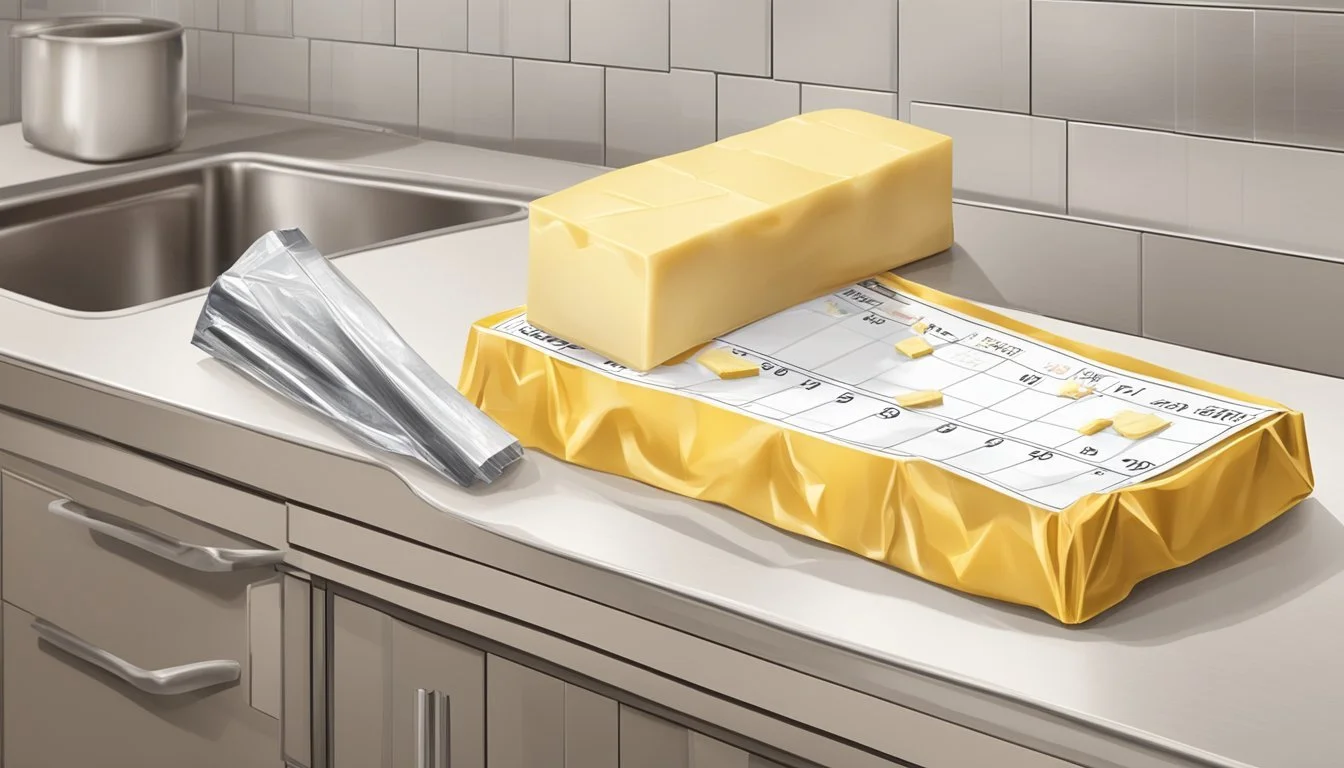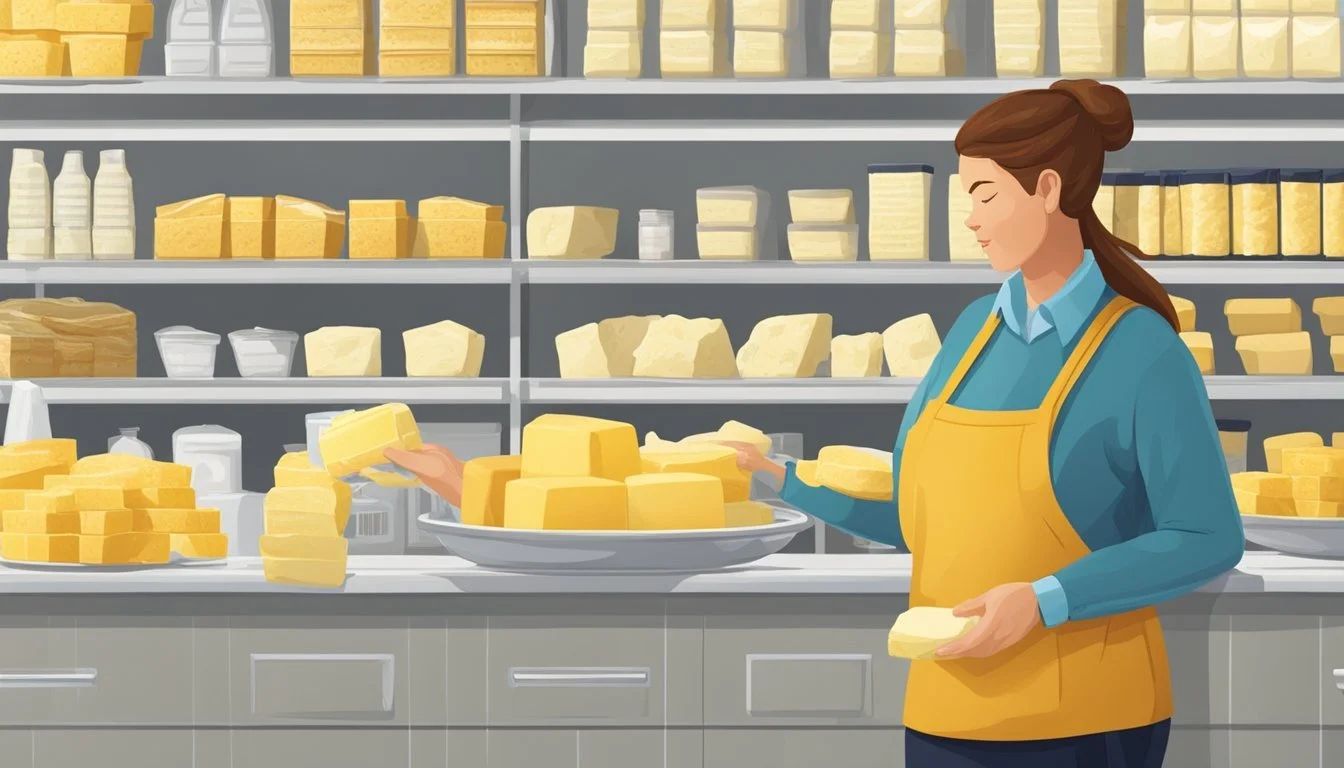How Long Does Butter Last?
Shelf Life and Storage Tips
Butter (how long does butter last?) is a staple in many households, valued for its rich flavor and versatility in cooking. It is made predominantly from the fat and protein components of milk or cream and is a key ingredient in a variety of culinary applications, from baking to sautéing. The freshness and quality of butter are essential for its taste and performance in recipes, making it important for consumers to understand its shelf life.
Under proper refrigeration, butter generally maintains its quality for several months. The expiration date printed on the packaging serves as a reliable indicator of how long it will stay fresh. Salted butter, due to its added sodium content which acts as a preservative, can have a longer shelf life compared to its unsalted counterpart.
As time passes, however, even refrigerated butter can experience changes that may affect its freshness and quality. Indicators of butter nearing or surpassing its prime include an off smell, a noticeable change in texture, discoloration, and the presence of mold. It is crucial for consumers to recognize these signs to ensure the butter they consume is not only flavorful but also safe.
Understanding Butter
In this section, the reader will learn about the different types of butter, their composition and fat content, and how butter is packaged. These factors influence butter's shelf life and quality.
Types of Butter
Butter can be categorized mainly into salted butter and unsalted butter. Salted butter has added salt, which acts as a preservative and flavor enhancer, while unsalted butter, also known as sweet cream butter, has no added salt and offers the true, unaltered taste of butter. Both types are common dairy products and used interchangeably in cooking and baking, depending on personal preference and recipe requirements.
Composition and Fat Content
Butter is composed primarily of fat, usually about 80%, with the remainder containing water and milk proteins. Its high fat content is responsible for butter's rich flavor and creamy texture. Fat content is also a determinant of how butter will stand up to cooking and how it can impact the flavor of dishes.
Fat: At least 80%
Water: Around 15-17%
Proteins and other components: 3-5%
Butter Packaging
The way butter is packaged can affect its exposure to light, air, and contaminants, which in turn influence how long it remains fresh. Butter is typically wrapped in foil or paper, often referred to as a "Flavor Protect® Wrapper," which is designed to maintain freshness and prevent absorption of other flavors. For longer shelf life, butter can be stored in the refrigerator or freezer, with proper packaging ensuring minimal flavor and texture changes over time.
Storage Recommendations
Proper storage of butter enhances its shelf life and preserves its quality. The ideal storage method depends on how quickly one intends to use the butter.
Refrigerating Butter
Keeping butter in the refrigerator is a common and safe method to prolong its freshness. Butter should be stored in its original packaging, or wrapped tightly to minimize exposure to odors and flavors from other foods. Typically, refrigerated butter lasts for one to three months.
Storing Butter on the Counter
Storing butter on the counter may provide a softer texture, suitable for easy spreading. However, this method increases the risk of spoilage and potential foodborne illness. If left on the counter, butter should be consumed within a few days, and an airtight seal or butter dish should be used to protect it from contaminants.
Freezing Butter
Freezing is an excellent option for long-term storage of butter. When stored in a freezer, butter can last up to a year without significant changes in taste or texture. To freeze butter, it should be kept in its original packaging, or wrapped in foil or plastic wrap to prevent freezer burn.
Butter Dishes and Crocks
Butter dishes and crocks can be used for both refrigerated and countertop storage, offering a balance between accessibility and protection. For countertop use, ensure the butter is covered to shield it from light and air. Butter crocks may provide an improved airtight seal, which can extend the freshness of butter when used properly.
Shelf Life of Butter
Butter longevity is contingent upon storage conditions and type, with sell-by dates serving as a general guideline rather than an expiration ultimatum.
Typical Shelf Life
Refrigerated butter typically has a shelf life of one month past the printed sell-by date. Unsalted butter tends to have a shorter lifespan than its salted counterpart by approximately 30 days due to the absence of salt, which acts as a preservative. When stored properly in the fridge, salted butter can retain freshness for several months.
Factors Affecting Shelf Life
Several key factors influence butter's longevity:
Temperature: Butter is prone to spoilage if kept at room temperature for prolonged periods, especially in warmer conditions.
Exposure to Air: When butter is not stored in an airtight container or tightly wrapped, it is susceptible to oxidation and contamination, which can hasten spoilage.
Humidity: High humidity levels within storage spaces can lead to butter spoilage through unwanted moisture.
Type of Butter: As previously noted, salted butter generally has a longer shelf life due to its preservative qualities.
Identifying Spoilage
Recognizing spoiled butter is crucial for food safety and avoiding the risks associated with consuming rancid products. Indicators of spoilage are primarily sensory changes, and understanding them helps prevent foodborne illnesses.
Spoiled Butter Indicators
Smell: Fresh butter has a clean, creamy scent. Spoiled butter will emit a strong, sour odor, indicative of bacterial growth.
Texture: Healthy butter should be uniform and smooth. If it feels sticky or has a grainy texture, it may have spoiled.
Color: Look for any discoloration or darkening of the butter, as this can be a sign of oxidation and spoilage.
Mold: Visible mold spots, which can be of various colors, are a clear indication of butter that has gone bad and should be discarded immediately.
Food Safety Concerns
Bacteria Growth: Butter that has spoiled may harbor harmful bacteria, increasing the risk of foodborne illness.
Consumption Risks: Ingesting spoiled butter can lead to symptoms of food poisoning, and as such, one must be stringent about discarding questionable butter.
Storage Practices: Proper refrigeration and handling reduce the risk of spoilage. Butter should be kept in an airtight container or wrapped to prevent exposure to air and contaminants.
By being attentive to these signs, individuals can ensure they do not consume spoiled butter, thereby maintaining food safety in their households.
Usage and Consumption
In the realm of culinary arts, butter plays a vital role due to its versatility in both cooking and as a spread. Its role is adjusted to suit the intended texture and flavor profile expected in a recipe.
Butter in Cooking and Baking
In baking, butter acts as a foundational ingredient that imparts richness and flakiness to pastries and doughs. Recipes often call for softened butter, which means that the butter is at room temperature and pliable enough to blend seamlessly with other ingredients. Achieving the correct consistency of butter is crucial in recipes for baked goods like cakes and cookies to ensure a perfect texture.
Spreading and Thawing Methods
For spreading, such as on toast, butter is preferred at a softer, more pliable state. Leaving butter out at room temperature for 30-60 minutes is usually sufficient for softening. To speed up the process, one can cut the butter into smaller pieces. When butter is stored in the refrigerator, it is recommended to use a covered dish or wrap it to maintain freshness. If butter is frozen, it can be thawed in the refrigerator overnight or gently in the microwave, using short intervals of 10 seconds to avoid melting. A butter substitute, such as margarine, may not require the same methods for spreading as it often has a softer consistency.
Preservation Tips
Proper storage is crucial in extending the shelf life of butter, ensuring it maintains its quality and taste. By controlling temperature and storage conditions, one can significantly prolong its usability.
Extending Butter's Lifespan
To extend butter's lifespan, refrigeration is essential. Butter should be stored at a temperature of about 40°F (4°C). For long-term preservation, butter can be frozen, with unsalted butter maintaining quality for up to one year. Freezing butter is straightforward:
Wrap the butter in its original packaging or aluminum foil.
Place the wrapped butter in a heavy-duty freezer bag or an airtight container.
Label the bag or container with the freezing date to track how long it has been stored.
Best Practices for Storage
When storing butter in the refrigerator or at room temperature, certain best practices are recommended:
Refrigeration: Keep butter in a covered dish or wrapped to protect it from light and odors. The ideal fridge temperature should be maintained below 40°F (4°C).
Room Temperature: A butter crock can keep butter fresh for a shorter period without refrigeration; ensure the crock is sealed and stored away from heat sources.
Margarine: Although not butter, margarine can be stored similarly; however, due to its different fat content and preservatives, it may have a longer shelf life.
Fat Content: Higher fat content butters, like European styles, can last longer due to reduced moisture content which can inhibit bacteria growth.
By following these tips, one can ensure their butter remains fresh, retains its flavor, and reduces the risk of spoilage.
Buying and Stocking
When purchasing butter, consumers should pay attention to the product's dating and consider appropriate storage methods to maximize shelf life.
Understanding Product Dating
Product dating on butter packages usually includes a "sell-by" or an "expiration" date. The "sell-by" date informs retailers of the last day the product should be offered for sale. It is a quality indicator and not a safety date. An "expiration" date, or "use by" date, suggests when the butter may start to decline in quality and flavor. However, if properly stored, butter can last beyond these dates without spoiling. Inspecting the label is essential for ensuring freshness upon purchase.
Purchasing and Sale Tips
Consumers should buy butter close to or before the "sell-by" date to ensure it is freshest. It’s advisable to stock up during a sale, but one should consider the storage space and usage rate to avoid waste. Butter can be stored in the refrigerator for a few weeks, and for extended use, freezing is an option, extending the life for months. When opting to buy in bulk during a sale, remember to store it properly to preserve quality.
Health and Nutritional Aspects
Butter plays a dual role in culinary applications by providing nutritional value and flavor. Understanding its health and nutritional aspects helps in making dietary choices.
Butter and Dietary Considerations
Butter contains calories and fat, primarily in the form of saturated fat, which can impact cardiovascular health when consumed in excess. A tablespoon of butter typically provides about 102 calories and 11.52 grams of fat. The high fat content in butter contributes to its rich flavor and creamy texture, but moderation is key in a balanced diet.
People often choose between salted and unsalted butter. Salted butter has added salt which can increase the sodium content of one's diet, while unsalted butter allows for more control over sodium intake and is preferred in baking where precise measurements are important.
Alternatives to Butter
For those seeking to reduce their intake of butter, there are several butter substitutes available:
Margarine: Made primarily from vegetable oils, it can have a similar texture to butter, but the health effects vary based on the type of oil used and the presence of trans fats.
Yogurt: It can occasionally be used as a lower-fat, tangy alternative to butter in recipes like baked goods or sauces.
Another consideration is the type of fat; butter substitutes often include a mix of saturated, monounsaturated, and polyunsaturated fats, which can be preferable for those managing their saturated fat intake.
Frequently Asked Questions
In this section, readers will find precise answers to common concerns regarding the storage, shelf life, and quality indicators of butter.
Common Queries About Butter
How long does butter last at room temperature?
Butter can remain at room temperature for brief periods, ideally not exceeding 1-2 days. To avoid spoilage and maintain quality, storing it in a French butter keeper can extend this duration slightly by keeping it cool and sealed away from air.
Is it necessary to refrigerate butter?
Yes, refrigeration is essential for prolonging the shelf life of butter. Typically, butter remains good in the refrigerator for about one to three months past the printed expiration date if it's unopened. However once opened, it's best to use it within a few weeks.
Can you freeze butter to extend its shelf life?
Butter can be frozen to extend its shelf life significantly, often up to a year. Ensure it is well wrapped to prevent absorption of odors and freezer burn.
What are the signs that butter has gone bad?
Rancidity in butter can be identified by an off smell, an unusual taste, discoloration, or mold. If any of these signs are present, it should not be consumed.
How to properly soften refrigerated butter for use?
To soften refrigerated butter, leave it out at room temperature for about 30-60 minutes. Alternatively, one can microwave the butter at 10-second intervals, being careful to not let it melt.
Remember, the key to maximizing butter's freshness is proper storage—either in a refrigerator, freezer, or a butter keeper designed for room temperature. Always check the butter for freshness using visual and scent clues before use, regardless of the expiration date.
Additional Insights
In evaluating butter's longevity, it becomes important to consider its multifaceted role in various cuisines and the innovation in its products that may influence shelf life and usage.
Butter's Role in Different Cuisines
European Cuisine: In Europe, especially in France, butter is integral to pastries and sauces. The texture and flavor of butter are critical in creating flaky layers in croissants (how long do croissants last?) and the rich taste in brioche. A classic French butter keeper, often made of ceramic, is used to maintain butter's freshness and spreadable consistency at room temperature.
South Asian Cuisine: Ghee, a form of clarified butter, is pivotal in South Asian dishes. It provides not only a distinct taste but also has a high smoke point suitable for various cooking techniques. Due to the removal of water and milk solids, ghee boasts a longer shelf life than regular butter, avoiding spoilage and retaining flavor for extended periods.
Innovations in Butter Products
Specialty Butters: Innovations such as whipped butter, which is aerated with nitrogen or air, offer a lighter texture and are easier to spread. Their altered state, however, can influence their longevity compared to traditional sticks of butter.
Refrigeration Technology: Advances in refrigeration technology have enabled consumers to store butter for longer without significant loss of quality. This helps to delay spoilage and maintain the butter's desired flavor and texture, which is essential in baking products like cookies and biscuits.
Butter continues to be a dynamic ingredient with considerations for storage and usage depending on the type of butter and the culinary context in which it is used.







